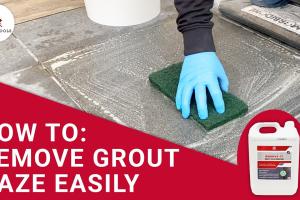Ultimate Guide to Removing Grout Haze: Techniques, Tips, and Tricks

-
Quick Links:
- Introduction
- What is Grout Haze?
- Causes of Grout Haze
- How to Clean Grout Haze
- Homemade Cleaning Solutions
- Store-Bought Cleaners
- Professional Cleaning Services
- Prevention Tips
- Case Study: Successful Grout Haze Removal
- Expert Insights
- FAQs
Introduction
Grout haze is a common problem faced by homeowners, particularly after installing new tiles. It can dull the appearance of your beautiful flooring or wall tiles, making them look unkempt and dirty. In this comprehensive guide, we’ll cover everything you need to know about how to clean grout haze effectively, prevent it from returning, and maintain your tiles for years to come.
What is Grout Haze?
Grout haze is a thin film that can develop on the surface of tiles after the grout has been applied and dried. This haze typically consists of excess grout, cement, and other particles that can leave a cloudy residue on the tile surface. Although it may seem minor, the presence of grout haze can significantly impact the aesthetics of your tiled surfaces.
Causes of Grout Haze
Understanding the causes of grout haze can help in both cleaning and prevention. The primary causes include:
- Excess Grout: When too much grout is applied or not wiped away properly during installation.
- Cement Residue: Leftover cement from the grout mixture that wasn't cleaned off.
- Moisture: Excess moisture can contribute to haze formation as it allows the grout to cure improperly.
How to Clean Grout Haze
Cleaning grout haze requires a systematic approach. Here’s a detailed step-by-step guide:
Step 1: Gather Your Supplies
To effectively clean grout haze, you'll need the following:
- A bucket
- Warm water
- A sponge or soft cloth
- White vinegar or a commercial grout haze remover
- A scrub brush or toothbrush
- A mop for larger surfaces
Step 2: Prepare the Area
Clear the area of any furniture or obstacles. Ensure that the tiles are dry before proceeding. This helps you to better see the haze and work effectively.
Step 3: Apply the Cleaning Solution
For homemade solutions, mix equal parts of warm water and white vinegar. Apply this to the grout haze with your sponge or cloth. If using a store-bought cleaner, follow the instructions on the label.
Step 4: Scrub the Haze
Using a scrub brush or an old toothbrush, gently scrub the grout haze. Be careful not to damage the grout or the tiles. Work in small sections for better results.
Step 5: Rinse Thoroughly
After scrubbing, rinse the area with clean water to remove any residue. Use a mop for larger areas to ensure all cleaning solution is removed.
Step 6: Dry the Area
Use a dry towel or cloth to wipe the tiles dry. This will help prevent new haze from forming due to leftover moisture.
Homemade Cleaning Solutions
If you prefer a more natural approach, consider these effective homemade solutions:
- Baking Soda Paste: Mix baking soda with water to form a paste. Apply to the haze and scrub gently.
- Citrus Cleaner: Combine lemon juice with vinegar for an acidic cleaner that cuts through haze.
Store-Bought Cleaners
There are several effective products available on the market. Look for cleaners specifically designed for grout haze. Some popular options include:
- Stonetech Heavy Duty Grout Haze Remover
- Miracle Sealants Grout Haze Remover
- Rust-Oleum Grout Cleaner
Professional Cleaning Services
If your grout haze is particularly stubborn, hiring a professional cleaning service may be the best option. Professionals have access to industrial-grade cleaners and equipment that can remove haze without damaging your tiles.
Prevention Tips
To avoid grout haze in the future, consider the following preventive measures:
- Always wipe away excess grout during installation.
- Use a grout release product before applying grout.
- Seal your grout to protect it from stains and haze.
Case Study: Successful Grout Haze Removal
In a recent case study, a homeowner discovered grout haze on their newly tiled kitchen backsplash. After attempting to remove it using just water and a sponge, they found limited success. They turned to a professional service, which utilized a combination of steam cleaning and a specialized grout haze remover, successfully restoring the tiles to their original condition.
Expert Insights
Experts recommend regularly maintaining your grout to prevent haze from forming. Regular cleaning and sealing can extend the life of your grout and keep your tiles looking brand new.
FAQs
1. What is the best way to remove grout haze?
The best method is to use a combination of homemade solutions, like vinegar and water, or a commercial grout haze remover, and scrub gently.
2. Can I use bleach to clean grout haze?
It's not advisable to use bleach as it can damage the grout and tiles. Stick with vinegar or specialized cleaners.
3. How long does grout haze last?
Grout haze can last indefinitely if not cleaned, but it is best to remove it as soon as possible for aesthetic reasons.
4. Can I prevent grout haze?
Yes, wiping away excess grout during installation and sealing your grout can help prevent haze.
5. Is professional cleaning worth it?
Professional cleaning can be more effective for stubborn haze and can save you time and effort.
6. How often should I clean my grout?
Regular maintenance, such as cleaning once a month, is recommended to prevent buildup and haze.
7. Can grout haze be removed from textured tiles?
Yes, but it may require more effort and a specialized approach to avoid damaging the texture.
8. Will vinegar damage my tiles?
While vinegar is safe for most tiles, avoid using it on natural stone surfaces, like marble or granite.
9. How do I know if my grout is sealed?
Perform a water test: sprinkle water on the grout. If it absorbs, it needs sealing.
10. What should I do if haze persists after cleaning?
If haze remains, consider contacting a professional for advanced cleaning methods.